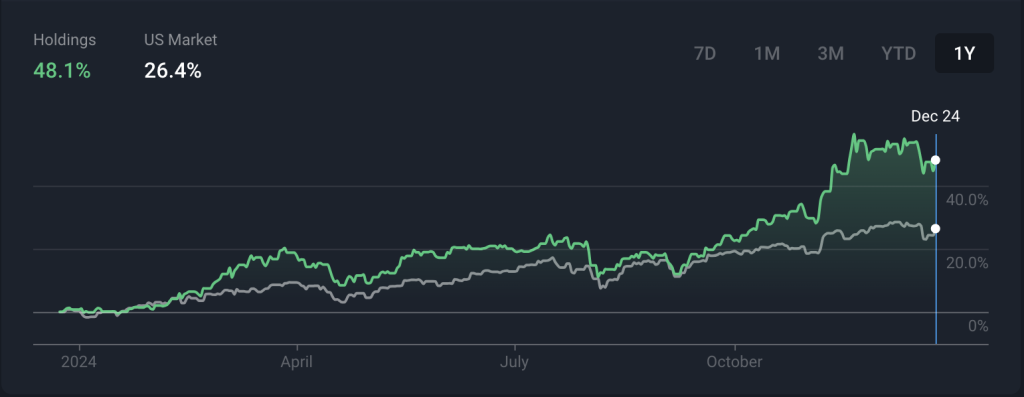
How to Build Wealth Through Smart Investing: A Practical Guide
In my previous posts, I focused mainly on upcoming technology for investing opportunities. Investing is one of the most effective ways to build long-term wealth, but it’s also an area where discipline and knowledge are crucial. Below are timeless principles and actionable tips for investors of all experience levels to consider.
But first, I want to look back at my own investments for the past year. My portfolio went up 48.1% compared to 26.4% for the US Market. This looks pretty impressive but I was a bit ‘lucky’. Although most of my assets are in a world wide index (IWDA), I picked up some stock that I wrote about in my previous posts, mainly MSTR and a little TSLA.

For the next year, I plan to focus more on value investing, following the tips below.
1. Pay Yourself First
The foundation of financial success starts with discipline. Commit to setting aside at least 10% of your income for investments. This “pay yourself first” principle ensures you’re prioritizing wealth-building over discretionary spending. Even small amounts matter over time.
2. Never Lose Money
Warren Buffett’s famous rule #1 is to never lose money. Here’s how you can adhere to this principle:
- Focus on Downside Risk: Before you invest, ask yourself, “What can go wrong?” A 50% loss requires a 100% gain just to break even.
- Invest in What You Understand: Avoid chasing trends or complicated schemes you can’t explain.
- Prioritize Value Over Price: A low price doesn’t guarantee value. Look for fundamentally sound businesses.
- Think Long Term: Be patient and avoid short-term speculation.
3. Harness the Power of Compounding
Albert Einstein once called compounding the eighth wonder of the world. The first rule of compounding? Never interrupt it unnecessarily. Invest consistently and give your money the time it needs to grow exponentially.
For me, the most important takeaway here is that you should start as soon as possible in your life. I failed to do that myself and missed a lot of compounding interests. But it’s never too late to start!
4. Look for Simple, Resilient Businesses
Charlie Munger advises investing in businesses that “any idiot can run” because, sooner or later, one probably will. Seek companies with:
- Strong, predictable cash flows
- Minimal reliance on complex management
- A durable competitive advantage (or “moat”)
5. Focus on Key Metrics
Building a solid portfolio involves understanding valuation and profitability metrics:
Relative Valuation:
- Compare similar assets using standardized variables like the price-to-earnings (P/E) ratio.
- Adjust for differences in growth, profitability, or risk.
Intrinsic Valuation:
- Calculate the intrinsic value by estimating future cash flows (e.g., owner’s earnings = operating cash flow – maintenance CapEx).
- Apply a discount rate to project the present value of future cash flows.
- Use a margin of safety: seasoned investors aim for 20-30%, while beginners should target 50%.
6. Create a Compounding Machine
Focus on reaching $100,000 in investments as quickly as possible. Afterward, let compounding work its magic. Diversify intelligently, but avoid over-diversification. Remember, diversification is protection against ignorance.
7. Build a Stock Screening Process
Use these steps to identify strong investments:
- Valuation: Look for a trailing P/E or TEV/EBIT below 15.
- Profitability: Seek companies with ROA > 10%.
- Growth: Ensure total revenue CAGR over the last 5 years is positive.
- Reliability: Review operating income over the last 5 years to check for stability.
- Deep Dive: Analyze the company’s competitive position and financial health.
8. When to Sell?
- When Something Better Emerges: If you find a more undervalued or promising opportunity.
- Corrected Undervaluation: When a stock’s price reaches its intrinsic value.
- Major Business Changes: Sell if the company’s economic fundamentals deteriorate.
- Portfolio Rebalancing: Consider trimming positions if a single stock becomes disproportionately large in your portfolio.
9. Embrace the Bear Case
The best investment opportunities often arise during bear markets. When others are fearful, focus on finding undervalued assets with strong fundamentals. The bear case is often the best case for long-term investors.
10. Build and Maintain a Stock Tracker
Monitor multiple stocks using a tracker to compare valuations, growth rates, and profitability. Patience is your ally—wait for the right opportunities to emerge.
Final Thoughts
Smart investing isn’t about flashy moves or getting rich overnight. It’s about avoiding mistakes, focusing on fundamentals, and allowing time and compounding to work in your favor. By following these principles and sticking to a disciplined approach, you’ll be well on your way to creating a compounding machine that builds wealth for years to come.
My final tip is this: if you are new to investing and don’t really know much about what you are doing, invest the majority of your holdings in a world-wide ETF. Make some smaller stock investments to learn the ropes. Don’t go all-in on some miracle stock. And never invest money that you can’t afford to lose.




